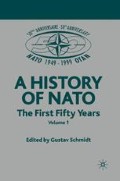Abstract
Fifty years ago in April 1949, a debate took place in the UN General Assembly. On the floor were two resolutions, one proposed by the Ad Hoc Political Committee and backed by Washington; the second proposed by Moscow. The first hoped to reform UN Security Council voting procedures in such a way as to limit the damage caused by Soviet abuse of its veto power (but not abolish the veto altogether).1 The Soviet draft sought to safeguard the veto granted by the UN Charter — and the “sovereignty” of the state.
Access this chapter
Tax calculation will be finalised at checkout
Purchases are for personal use only
Preview
Unable to display preview. Download preview PDF.
Notes
For alternative interpretations, see Martin A. Smith, “At Arm’s Length: NATO and the United Nations in the Cold War Era,” International Peacekeeping, Vol. 2, No. 1, Spring 1995, 61; Lawrence A. Kaplan, “NATO and the UN: A Peculiar Relationship” Contemporary European History, 7, 3 (1998), 329–342.
Senator Arthur H. Vandenberg, The Private Papers of Senator Vanden-berg, (Houghton Mifflin, 1952), 474.
On the “double containment” of Germany, see Hall Gardner, Surviving the Millennium (Westport, CT: Praeger, 1994); Dangerous Crossroads (Westport, CT: Praeger, 1997). The double enlargement of NATO and the EU likewise serves, in part, to “double contain” German power capabilities.
Arthur M. Cox, Prospects for Peacekeeping (Washington, DC: Brook-ings, 1967), 55. In 1962, the International Court of Justice accepted the legality of international peacekeeping.
James A. Baker, The Politics of Diplomacy (New York: Putnam, 1995), 637–38.
See Peter Barschdorff, “Can NATO Deliver?” SAIS Review Vol. XVIII, No 2, Summer-Fall 1998; Gregory L. Schulte, “Former Yugoslavia” Survival 39:1 (Spring 1997), 19–42.
Terry Terriff and James F. Keeley, “The United Nations, Conflict Management and Spheres of Influence”, International Peacekeeping, Vol. 2, No. 4, Winter 1995, 518; 533–43.
Sir W. Eric Beckett, “The North Atlantic Treaty, the Brussels Treaty and the Charter of the United Nations,” cited in Lord Ismay, NATO: The First Five Years (Netherlands: Bosch-Utrecht, 1954), 13–14.
Arthur M. Cox, Prospects for Peacekeeping (Washinton, DC: Brookings, 1967), 55. The US Senate subsequently urged NATO to develop a formal dispute resolution mechanism.
John Barrett, “Conflict Prevention and Crisis Management: The NATO Approach” in The Art of Conflict Prevention, eds. Werner Bauwens and Luc Reychler (London: Brassey’s, 1994), 130.
See Lincoln P. Bloomfield, The United Nations and U.S. Foreign Policy (Boston: Little Brown, 1960), 60–61.
Editor information
Editors and Affiliations
Copyright information
© 2001 Palgrave Macmillan, a division of Macmillan Publishers Limited
About this chapter
Cite this chapter
Gardner, H. (2001). NATO and the UN: The Contemporary Relevance of the 1949 North Atlantic Treaty. In: Schmidt, G. (eds) A History of NATO — The First Fifty Years. Palgrave Macmillan, London. https://doi.org/10.1007/978-1-349-65576-2_4
Download citation
DOI: https://doi.org/10.1007/978-1-349-65576-2_4
Publisher Name: Palgrave Macmillan, London
Print ISBN: 978-1-349-65578-6
Online ISBN: 978-1-349-65576-2
eBook Packages: Palgrave Political & Intern. Studies CollectionPolitical Science and International Studies (R0)

